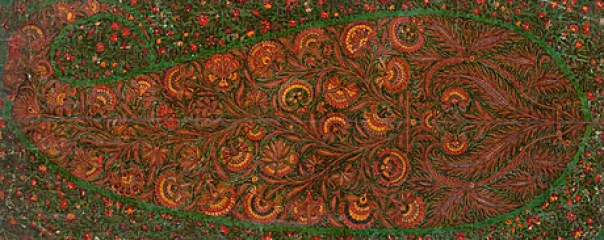From Mughals to Minis: The Enduring Paisley Motif
August 15, 2022

Very few design motifs have withstood the vicissitudes of fashion as well as paisley. It’s incredibly versatile—cacophonous and ebullient elements can be channeled into a sophisticated all-over pattern or individual “pine cones” can be released on their own to create a simple appealing repeat. Through the centuries its motifs have been transformed, embellished, and recombined endlessly. Along with plaid paisley survives as the most successful example of textilian natural selection.
Paisley’s noble and exotic associations have surely contributed to its longevity. Who could resist an ancient design associated with fertility, which has traversed so much far-flung history— ancient Babylon, Mughal courts, Napoleon’s North African campaigns, the British Raj, the Industrial Revolution, and The Summer of Love?

The original tear drop or pine cone shape—boteh or buta—is believed to have originated in Persia sometime in the first century AD. Boteh derives from the Persian word for flower and the motif may represent a floral spray combined with a cypress tree, a Zoroastrian symbol of life and eternity. The motif may have influenced by the Babylonian stylization of the palm leaf, also a fertility symbol, palms being considered to be the Tree of Life.
The boteh began as a fairly simple and naturalistic plant rendering used in both fabric and art; artists and weavers of the Mughal court attempted to imitate European botanical studies typical of the 17th century. Stylistically, the evolution of the boteh owes much to traditional Persian floral design as expressed in carpets, tiles, and miniatures. By the 1700s, however, the boteh had become embellished with additional flowers and tendrils. Eventually all those elements morphed into slender conical “tree” with with a bent tip. Finally the motif evolved into the elongated serpentine abstraction that today we recognize as the paisley pattern.

Gouache on paper, varnished; sheet: 15 3/4 x 6 1/2″
The Fashionable Pine Cone
As early as the 11th century, Kashmiri weavers had been making fine woolen shawls. These textiles were created using fibers from the wool undercoat (pashmina) of half-wild Tibetan goats and woven according to a specific “twill tapestry” method that can be dated with certainty to the 15th century.
Unlike plain weave Kashmiri shawls are created by using the horizontal weft threads alone to form the pattern. These weft threads did not run full width of the cloth; rather they were inserted at various points by hand only where a particular color was needed. Additionally they were woven into the warp without the use of the traditional shuttle. To create a larger shawl, separately-woven borders were sewn to the primary square, and then often overbound with silk. This was an intricate and time-consuming process that could take up to 18 months to complete.
Beginning in the 16th century, the Mughal emperors elevated Kashmiri shawls to noble status, typically wearing them as sashes around their waists or across their chest. (The English word “shawl” derives from the Indo-Persian shal, which loosely refers to a “fine woven woolen fabric” not an article of clothing.) Turkistan weavers, enticed to Kashmir because of their renown skills, left their mark on the garment, as did later Afghan and Sikh conquerers.

The European craze for cashmere at the end of the 18th century was said to have started through a series of hand offs that began with a blind man from Baghdad, who visiting in Kashmir was presented with an orange shawl by the Afghan Governor. The blind man in turn gave the shawl to Muhammad Ali Pasha, the Khedive (prince) of Eqypt, who in turn re-gifted it to Napoleon (perhaps as a gesture of peace at the conclusion of French commander’s successful Eqyptian campaigns?). Upon his return to Paris, Napoleon bestowed it upon his wife Josephine, who enthusiastically added the piece to her costume, draping it over her shoulder and arms as was the custom in pre-Regency Europe. For reasons that had as much to do with flattering the Empress as with the luxurious feel of the cloth, Kashmiri shawls soon became an indispensable accessory of Parisian aristocratic couture.

The Marquise de Sorcy, painted by Jacques-Louis David, has wrapped herself in what looks very much like a Dochalla shawl.
By the early 1800s a thriving trade connected Kashmir and Europe. The making of shawls constituted a primary source of revenue in Kashmir in the early years of the 19th century. In 1821, William Moorcroft, an agent for the East India Company, reported as many as 50 looms in one Kashmiri karkhana. Typically shawls were distributed to the East through Central Asian merchants and to the West by agents in Europe and Russia.

From Boteh to Paisley
The Kashmir shawl arrived in England in the mid-18th century, not probably through France, but through agents of the British East India Company. Given the British penchant for romanticizing the exoticness of the East, it quickly became an article of high-fashion there too. Shawls remained prohibitively expensive until the English devoted considerable resources to producing a domestic copy. Although the earliest imitations of Kashmir patterns came from Edinburgh, the English town of Norwich was the first established European center of shawl weaving.

In 1812, an inventor in the town of Paisley (just west of Glasgow, Scotland) introduced a device that allowed five shuttles to be held on a loom simultaneously, thus greatly facilitating the manufacture of multicolored designs. Buddies (citizens of Paisley) excelled at pirating designs and quick production turn around, practices that allowed them to quickly dominate the trade. With the advent of mechanized looms in the 1860s, Paisley, like Scotchtape, became the brand name for shawls and the designs on them.
Paisley Goes Mass Market
The Industrial Revolution put the price of woven shawls within reach of every English lady. Paisley proved so popular that European manufacturers eventually dispensed with weaving altogether, instead printing the designs on a cotton plain weave using enormous copper rollers. In moving to the wider world of patterned fabrics, paisley took its first steps into the mass market. Ironically, it proved so successful as a printed design that, by the later 19th century, even Indian textile producers had taken up the habit of printing paisley designs on cotton, although a lot of their fabrics were hand-printed using wooden textile blocks the one pictured at the top of this post.

The introduction of the bustle in the late 1860s may have caused paisley’s (temporary) demise. Bustles disrupted the flow of the large shawl, so women largely abandoned them for short jackets. Or maybe, in a classic tale of fashion trickle-down, upper-class ladies abandoned Kashmir shawls precisely because they had reached mass-market status.
Paisley Endures
Even so, paisley managed to limp along into the first half of the 20th century as a printed fabric pattern, most of the time on cravats and tablecloths. Then, in the 1960s and 70s as hippies fanned out across Asia on journeys of discovery, paisley on couture came roaring back. Rock and rollers did their bit—in particular the Beatles, during their Eastern-influenced phase. And, of course, The Summer of Love, when a souped psychedelic aesthetic, surely enhanced by acid, produced eye-popping paisleys.


Into the 21st century paisley is ebulliently evolving, enduring in fashion both low and high. Long live paisley!


Visitations
Paisley, Scotland
Jacques-Louis David at the Louvre
Textile Museum, George Washington University
The Textile Center, Leiden
Postscript
More on the Kashmir Paisley Shawl

Related
Comments are closed.